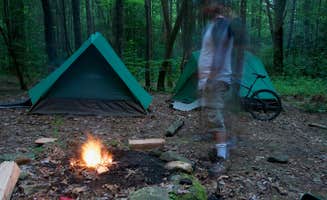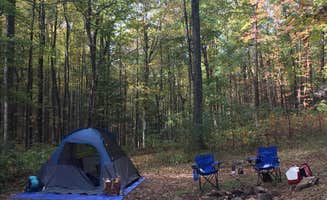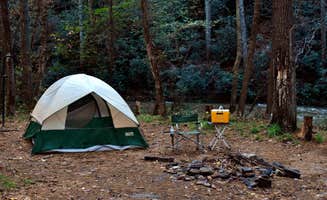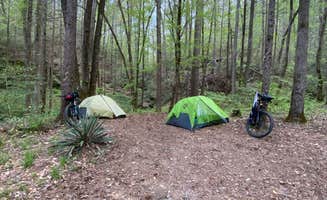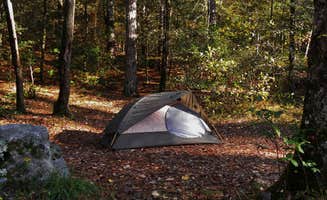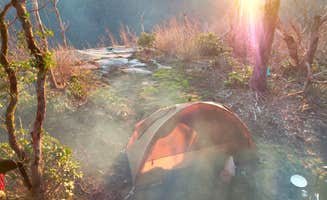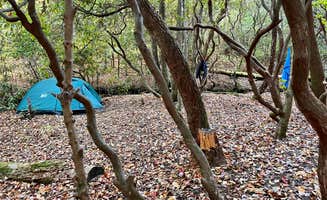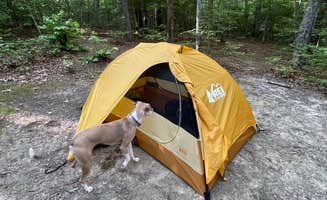Dispersed camping near Lakemont, Georgia sits within the Chattahoochee-Oconee National Forest at elevations between 1,200-2,000 feet, creating moderate year-round temperatures compared to surrounding lowlands. The area receives approximately 70 inches of rainfall annually, making water sources plentiful but creating potentially muddy conditions after heavy precipitation. Forest service roads accessing many campsites can become difficult to navigate during wet periods, particularly in winter and spring.
What to do
Waterfall exploration: 1-2 mile hikes lead to accessible falls throughout the region. At Raven Cliff Falls, "the trail doesn't quite end there. Once you arrive at the falls there's plenty of room to roam the dozens of rock structures. This is one you'll definitely want to bring your camera with." The moderate 5-mile round trip hike rewards visitors with cascading water through dramatic rock formations.
Trout fishing: Year-round opportunities in mountain streams require Georgia fishing license. At Burrells Ford, "good trout fishing. Fishing license is required but both SC and GA are acceptable as the river is the state line." Most productive fishing occurs during spring and fall when water temperatures remain cool.
Natural water features: Rock slides and swimming holes provide summer recreation when temperatures reach the 80s. "Wildcat Creek has a cool water slide for adults and kids to have fun and cool off with." The natural stone water slide forms a gentle slope into a deep pool, perfect for cooling off after hiking.
What campers like
Privacy between sites: Many locations offer natural separation beyond what's described in established campgrounds. At Grapevine, "sites are spread out, nice river nearby." This spacing creates a more secluded experience than typical commercial campgrounds, with tree cover providing additional separation.
Water access for filtering: Proximity to clean mountain streams eliminates the need to carry large water supplies. "Water is no problem with the entire trail being directly on a solid flowing stream." Most campsites require water filtration systems as potable water sources are limited.
Established fire rings and lantern poles: Despite primitive settings, many sites include basic amenities. At Burrells Ford, "I was surprised to find a nice large picnic table and lantern pole. Most hike-in sites don't have these amenities. There was also a hanging system for food since this place is in bear country." These features reduce campsite impact while providing practical functionality.
What you should know
Access limitations: Forest roads require high-clearance vehicles in some areas. "E. Wildcat rd. Is residential, (you want W. Wildcat rd.)." Travel during wet weather can become challenging, particularly after heavy rainfall when some roads become temporarily impassable.
Bear activity: Food storage precautions required throughout the region. "Great water and even a late night bear visit so best to raise your food up a free hanging rope." Black bears remain active throughout three seasons, making proper food storage essential at all campsites.
Seasonal crowding: Popular areas fill quickly during peak periods. At Panther Creek Recreation Area, "it was closed for covid for a bit so things are a little overgrown around the rec area. It's $4 to park in the lot... My only complaint is how packed it is on the weekends. There's 150+ cars parked all on the side of the road." Arrive mid-week for better site availability.
Tips for camping with families
Child-friendly waterfalls: Short hikes suitable for younger explorers. "King Creek Falls. The trail to the waterfall is over a half mile (my estimation), and you have to cross a log footbridge." The moderate terrain provides natural discovery opportunities while remaining accessible for children.
Swimming opportunities: Natural pools provide safe water play areas during summer months. "The waterfall is amazing with a large pool and nice sandy beach at its base. Perfect for swimming and cooling off after the hike or camping if you are lucky enough to snag it before someone else." These natural features require parental supervision but offer excellent cooling options.
Campfire cooking: Established fire rings make meal preparation straightforward. At Wildcat 1, the "site was a solid basecamp with little frills or features." Pack food requiring minimal cooking equipment, as most sites lack tables or other food preparation surfaces.
Tips from RVers
Length restrictions: Small rigs only on forest roads leading to most sites. At Owls Retreat Campground, they offer "electric-hookups" and "thirty-amp-hookups" which makes this one of the few options for RVs requiring power. Most forest service roads limit access to smaller vehicles under 26 feet.
Limited hookup availability: Plan for dry camping at most locations. "We stayed in the parking lot in our small rig. (Under 26 ft) we had our super quiet generator running and had no issues." Prepare for self-contained camping without water, electric, or sewer connections at most dispersed sites.
Alternative options: Commercial campgrounds provide more amenities when needed. Several private campgrounds near Lake Burton offer full hookups with shower facilities as alternatives to primitive camping options within the national forest.




